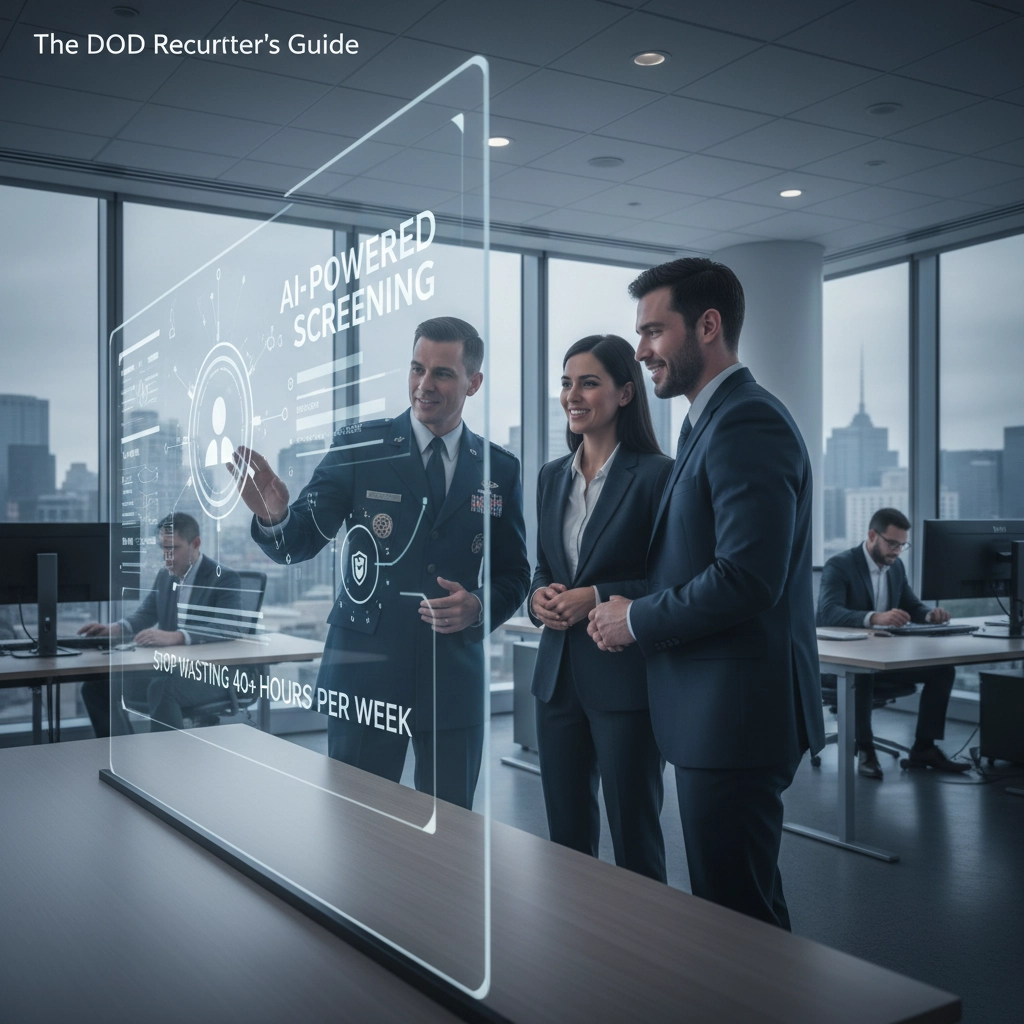The Department of Defense recruitment landscape has undergone significant transformation as traditional screening methodologies prove increasingly inadequate for modern hiring demands. Current screening processes consume substantial resources, with recruiters dedicating approximately 23 hours to screen candidates for a single position, creating bottlenecks that delay critical staffing decisions and compromise operational readiness.
Current Screening Inefficiencies in DoD Recruitment Operations
Traditional candidate evaluation methods present numerous challenges that directly impact recruitment effectiveness and resource allocation. Manual resume screening introduces inconsistencies in candidate assessment, with different recruiters interpreting identical qualifications through varying lenses of experience and preference. This variability undermines standardization efforts and creates potential legal vulnerabilities in hiring practices.
The proliferation of artificial intelligence tools among job seekers has fundamentally altered the application landscape. Contemporary research indicates that nearly fifty percent of candidates now utilize AI-powered assistance for job applications, resulting in recruitment teams processing three to six times more applications than previous operational periods. This surge in application volume, combined with declining application quality and poor job fit alignment, has created unprecedented screening burdens for recruitment personnel.
"The traditional 23-hour screening commitment per hire represents a significant resource allocation challenge that artificial intelligence can effectively address through automated initial assessment stages."

Traditional screening methodologies also perpetuate unconscious bias patterns that can undermine diversity and inclusion objectives. Human reviewers, despite best intentions, may inadvertently favor candidates whose backgrounds mirror their own experiences or educational pathways. These bias patterns become particularly problematic when recruiting for specialized technical positions where diverse perspectives enhance operational effectiveness.
DoD's Comprehensive AI-Powered Assessment Infrastructure
The DoD Chief Information Office has developed a sophisticated online assessment platform specifically engineered for Cyber Excepted Service positions. This system integrates artificial intelligence capabilities with traditional assessment methodologies to create a comprehensive evaluation framework that addresses multiple screening dimensions simultaneously.
The platform's multi-hurdle assessment architecture enables position-specific customization while maintaining consistent evaluation standards across different occupational categories. This flexibility ensures that technical positions receive appropriate technical assessments while administrative roles undergo relevant administrative evaluations, all within the same integrated system framework.
Core assessment capabilities include structured phone screening protocols, cognitive testing modules, and comprehensive questionnaire systems. The platform offers traditional Knowledge, Skills, and Abilities assessments alongside competency-based assessments and flexible questionnaire options that adapt to specific position requirements. Each assessment type provides automated draft generation based on position documentation and hiring manager input, significantly reducing preparation time for recruitment teams.
The system incorporates behaviorally-based interview frameworks utilizing crediting plan methodology, whether conducted through panel interviews or individual hiring manager sessions. These structured interviews ensure consistent candidate evaluation while providing flexibility for different interview formats and organizational preferences.
Strategic Implementation of Automated Screening Protocols
Multi-hurdle assessment implementation creates systematic candidate filtering that progressively eliminates unqualified applicants before human review stages. This approach ensures that recruitment personnel invest time exclusively in candidates who meet established qualifications and demonstrate genuine interest in federal service.
Automated eligibility verification represents a significant advancement in screening efficiency. The system captures and evaluates eligibility requirements during the application process, including veterans preference status, citizenship verification, and program-specific requirements. This automated verification eliminates manual documentation review that previously consumed substantial recruitment time.

Security integration capabilities streamline background investigation screening and suitability determinations from initial application stages. The platform includes security question evaluation protocols that initiate background investigation processes early, reducing timeline delays associated with security clearance processing.
"Automated screening platforms can effectively identify AI-generated applications through relevant job-related follow-up questions and engaging conversation analysis, enabling recruiters to focus on genuine candidates."
Advanced Counter-AI Screening Strategies
Contemporary recruitment environments require sophisticated approaches to address AI-enhanced candidate applications. Cognitive ability and personality trait assessments provide AI-resistant evaluation methods that reveal genuine candidate capabilities beyond surface-level application materials. These assessments should be administered early in the screening process to filter candidates before investing substantial interview time.
Enhanced screening efficiency emerges through AI-powered conversation analysis that identifies genuine candidate engagement versus automated response patterns. Recruitment platforms can analyze candidate interactions to determine authentic interest levels and qualification alignment, providing recruiters with data-driven insights for advancement decisions.
Automated communication management systems enable personalized candidate outreach while preserving human oversight for critical decisions. These systems can craft position-specific communications and manage initial candidate interactions, allowing recruitment personnel to focus on high-value activities requiring human judgment and relationship-building capabilities.
Implementation Best Practices for Organizational Success
Successful AI implementation requires maintaining human authority over final candidate advancement decisions. While automated screening tools provide valuable efficiency gains, human recruiters must retain decision-making responsibility to ensure fair evaluation and prevent over-reliance on algorithmic determinations. This human oversight becomes particularly important when evaluating candidates who may not utilize AI assistance for their applications.

Recruitment personnel should focus on developing communication, relationship-building, and adaptability skills as AI systems handle routine screening tasks. These distinctly human capabilities remain superior to technological solutions and become increasingly valuable as AI adoption expands across recruitment operations.
Continuous assessment calibration ensures that AI systems maintain relevance and accuracy over time. The platform allows ongoing refinement of assessment criteria based on hiring outcomes and performance data, ensuring that screening protocols continue identifying candidates who succeed in their assigned roles.
Measuring Operational Impact and Return on Investment
Implementation of AI-powered candidate screening delivers quantifiable benefits for DoD recruitment operations through dramatic time reduction and improved candidate quality. By automating initial screening stages, recruitment teams can reduce the traditional 23-hour screening commitment to a fraction of previous time investments while maintaining or improving hiring quality standards.
Multi-hurdle assessment protocols create comprehensive evaluation processes that reduce hiring mistakes while accelerating overall recruitment timelines. This systematic approach enables DoD organizations to fill critical positions more rapidly while preserving high-quality hiring standards essential for mission success.
"The platform's integration of various assessment types creates a comprehensive evaluation process that reduces hiring mistakes while accelerating timeline completion."
The transformation from reactive to proactive recruitment methodologies represents a fundamental paradigm shift where technology handles routine screening while human expertise concentrates on strategic decision-making and relationship building. This evolution saves substantial time resources while enhancing overall hiring decision quality across Department of Defense operations.
Resource allocation improvements extend beyond time savings to include enhanced candidate experience and improved organizational reputation. Streamlined screening processes reduce candidate wait times and provide clearer communication throughout the evaluation process, contributing to positive perceptions of federal employment opportunities.
Long-term operational benefits include improved retention rates through better candidate-position alignment and reduced recruitment cycle times that enhance organizational agility. These improvements contribute to overall mission readiness by ensuring that critical positions are filled efficiently with qualified personnel who demonstrate long-term success potential.

